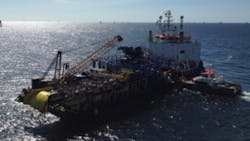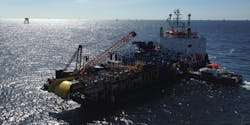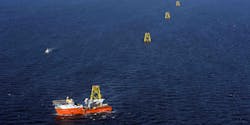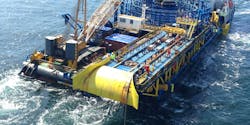Inter-Array Cabling for Nordsee Ost Offshore Wind Farm Completed Ahead of Schedule
A network of more than 60 km of underwater cable now spreads over the construction field of the Nordsee Ost offshore wind farm. This is almost the length of the Eurotunnel that connects the UK with Continental Europe. The inter-array cabling was completed in altogether less than four months.
"We divided cable installation into two campaigns. The first 30 km of cable or so were already installed and buried in the seabed last year. This took off some of the time pressure from the most intricate process. The remaining cables were laid over the last few weeks", explained Marcel Sunier, Project Director for Nordsee Ost at RWE Innogy. "The team did an excellent job. They completed the work around two weeks ahead of the original schedule." The cable work was carried out by the Dutch company Visser & Smit Marine Contracting.
All 48 foundations for the wind turbines and the foundation of the substation were connected with each other by so-called inter-array cables. The 33-kV underwater cables have a diameter of up to 16 cm. A particularly robust sheathing protects the cables from the extreme stresses caused in particular by the installation process out at sea. At the same time, they guarantee maximum power transmission across large distances. Special-purpose cable laying vessels were used to install these high-capacity power lines.
Two of these special installation vessels, the "Normand Flower" (in 2013) and the "Stemat Spirit " (in 2014) were in operation at the Nordsee Ost wind farm. At the port of Landskrona, Sweden, they took up to 30 km of cable on board before taking off to the wind farm’s construction field. Upon arrival, they connected twelve foundations in a so-called loop each time. For this purpose, the cables first had to be cut to the right length, which was done on board. Subsequently, the cable ends were pulled into the cable tunnels provided in the foundation where they were fastened. The cables connecting the individual foundations were buried at a depth of around 1 ½ m in the seabed. Subsequently, diving robots, so-called remotely operated vehicles (ROVs), surveyed the final cable position and checked the proper functioning of the cables laid.
In August the inter-array cables will be connected with the offshore substation, the nerve center of the wind farm. The substation transforms the electricity generated by the wind turbines at 33 kV to a transmission voltage of 155 kV so that the electricity can be transmitted via high-voltage undersea cables to the coast. The substation of the Nordsee Ost wind farm is around 15 m high and weighs approx. 2,000 tons. Like the wind turbines, it is mounted on a steel structure foundation in the seabed and will tower around 35 m above sea level after final assembly. The steel foundation which weighs around 700 tons was already installed in July 2013. The actual substation platform (topside) is to follow in mid-July.
The 48 foundations for the wind turbines at the Nordsee Ost wind farm were completed in mid-March 2014. In May, construction started on the wind turbines. After their completion, scheduled for spring 2015, the Nordsee Ost offshore wind farm will have an installed capacity of around 295 MW and supply an equivalent of some 300,000 households with electricity every year. Equipped with the currently most powerful offshore turbines, Nordsee Ost is one of the largest commercial wind power projects off the German coast.



